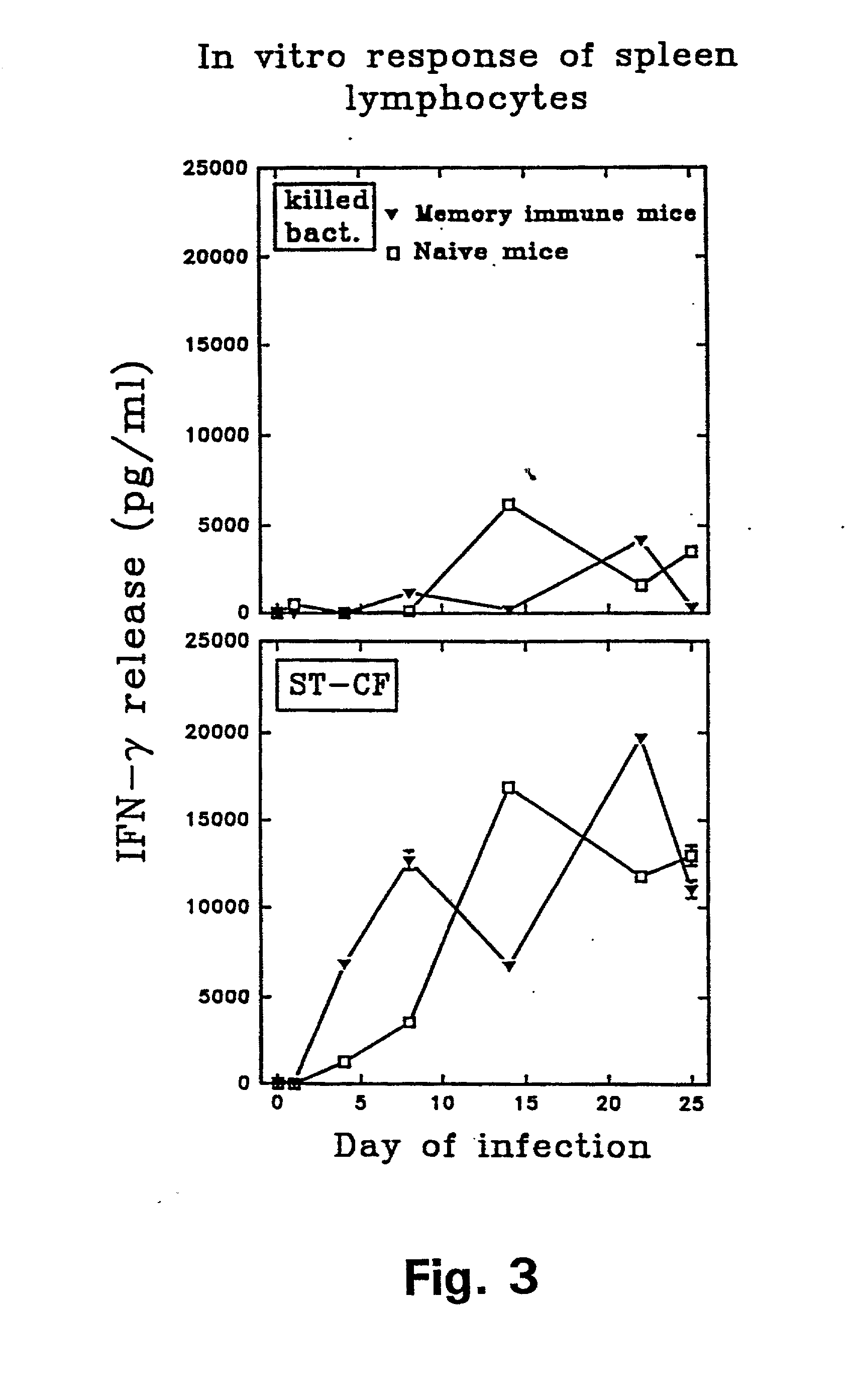M. tuberculosis antigens
a tuberculosis and antigen technology, applied in the field of m . tuberculosis antigens, can solve the problems of inability to predict the translation of dna, the inability of sequence information to predict the effect of dna translation, and the failure of trials in developing countries to demonstrate significant protection
- Summary
- Abstract
- Description
- Claims
- Application Information
AI Technical Summary
Benefits of technology
Problems solved by technology
Method used
Image
Examples
example 1
[0107] Isolation of T-cell Stimulating Low Molecular Weight ST-CF Antigens
[0108] Bacteria. M. tuberculosis H37Rv (ATCC 27294) was grown at 37.degree. C. on Lowenstein-Jensen medium or in suspension in modified Sauton medium. BCG Copenhagen was obtained as a freeze dried vaccine and were rehydrated with diluted sauton followed by a brief sonication to ensure a disperse suspension.
[0109] Production of short-term culture filtrate (ST-CF). ST-CF was produced as described previously (Andersen et al., 1991b). Briefly M. tuberculosis (4.times.10.sup.6 CFU / ml) were incubated in Sauton medium and grown on an orbital shaker for 7 days. The bacteria were removed by filtration and the culture supernatants were passed through sterile filters (0.2 .mu.m) and concentrated on an Amicon YM 3 membrane (Amicon, Danvers, Mass.).
[0110] Fractionation of ST-CF by the multi-elution technique. ST-CF (5 mg) was separated in 10-20% SDS-PAGE overnight (11 cm vide centerwell, 0.75 mm gel). After the termination...
example 2
[0120] Cloning of Genes Expressing Low Mass Culture Filtrate Antigens
[0121] In example 1 it was demonstrated that antigens in the low molecular mass fraction are recognized strongly by cells isolated from memory immune mice. Monoclonal antibodies (mAbs) to these antigens were therefore generated by immunizing with the low mass fraction in RIBI adjuvant (first and second immunization) followed by two injections with the fractions in aluminium hydroxide. Fusion and cloning of the reactive cell lines were done according to standard procedures (Kohler and Milstein 1975). The procedure resulted in the provision of two mAbs: ST-3 directed to a 9 kDa culture filtrate antigen (CFP9) and PV-2 directed to a 7 kDa antigen (CFP7), when the molecular weight is estimated from migration of the antigens in an SDS-PAGE.
[0122] In order to identify the antigens binding to the Mab's, the following experiments were carried out:
[0123] The recombinant .lambda.gt11 M. tuberculosis DNA library constructed b...
example 3
[0146] Identification of Antigens which are not Expressed in BCG Strains.
[0147] In an effort to control the treat of TB, attenuated bacillus Calmette-Gurin (BCG) has been used as a live attenuated vaccine. BCG is an attenuated derivative of a virulent Mycobacterium bovis. The original BCG from the Pasteur Institute in Paris, France was developed from 1908 to 1921 by 231 passages in liquid culture and has never been shown to revert to virulence in animals, indicating that the attenuating mutation(s) in BCG are stable deletions and / or multiple mutations which do not readily revert. While physiological differences between BCG and M. tuberculosis and M. bovis has been noted, the attenuating mutations which arose during serial passage of the original BCG strain has been unknown until recently. The first mutations described are the loss of the gene encoding MPB64 in some BCG strains (Li et al., 1993, Oettinger and Andersen, 1994) and the gene encoding ESAT-6 in all BCG strain tested (Harb...
PUM
| Property | Measurement | Unit |
|---|---|---|
| Fraction | aaaaa | aaaaa |
| Fraction | aaaaa | aaaaa |
| Time | aaaaa | aaaaa |
Abstract
Description
Claims
Application Information
 Login to View More
Login to View More - R&D
- Intellectual Property
- Life Sciences
- Materials
- Tech Scout
- Unparalleled Data Quality
- Higher Quality Content
- 60% Fewer Hallucinations
Browse by: Latest US Patents, China's latest patents, Technical Efficacy Thesaurus, Application Domain, Technology Topic, Popular Technical Reports.
© 2025 PatSnap. All rights reserved.Legal|Privacy policy|Modern Slavery Act Transparency Statement|Sitemap|About US| Contact US: help@patsnap.com



